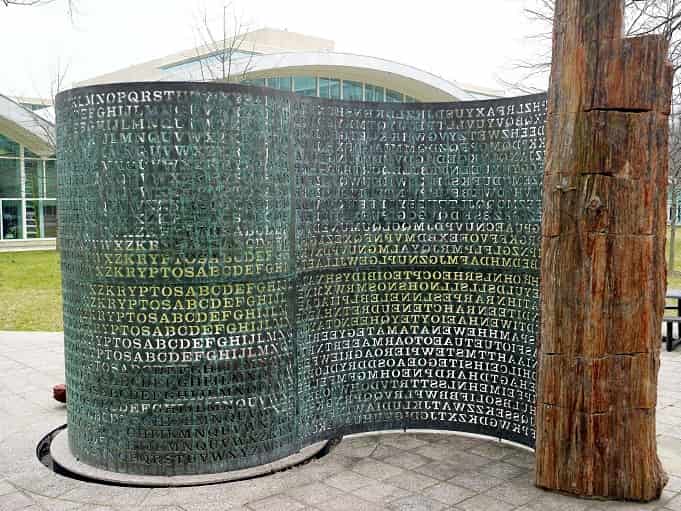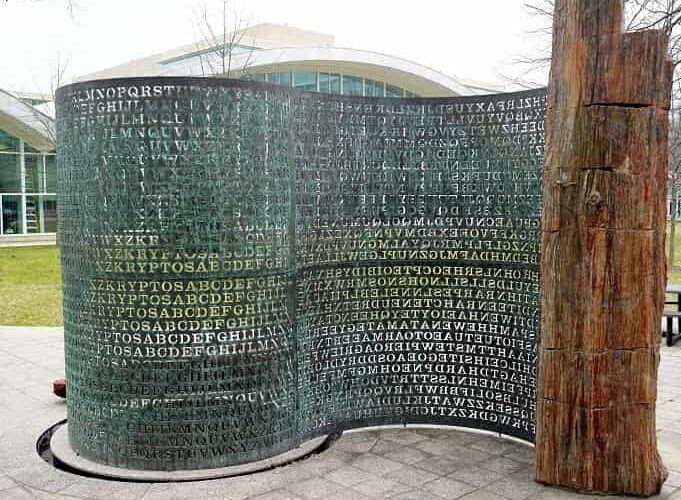The Mysterious Kryptos Sculpture: A CIA Puzzle Unsolved for Decades

Hidden outside the CIA headquarters in Virginia, USA, stands a mysterious copper sculpture called Kryptos. Created in 1990 by artist Jim Sanborn, this artwork is not just a visual masterpiece—it’s a complex puzzle that has confused codebreakers, spies, and curious minds for over 30 years.
With four secret messages carved into its surface, three of which have been solved, Kryptos remains one of the world’s most famous unsolved codes. This article explores the story behind the sculpture, its creator, the secrets it holds, and why it continues to fascinate people around the globe.
What Is the Kryptos Sculpture?
Kryptos (meaning “hidden” in Greek) is a 12-foot-tall, curved copper wall covered with nearly 2,000 letters, numbers, and symbols. It sits in the courtyard of the CIA’s headquarters in Langley, Virginia. The sculpture looks like a giant piece of paper emerging from the earth, with text carved in a way that resembles ancient scrolls. But this isn’t ordinary text—it’s a series of encrypted messages waiting to be decoded.
The sculpture has four sections, labeled K1, K2, K3, and K4. Of these, only K4 remains unsolved. Over the years, everyone from CIA agents to amateur codebreakers has tried—and failed—to crack its final secret.
The Artist Behind the Mystery: Jim Sanborn
Jim Sanborn, a sculptor from Washington D.C., was hired by the CIA in 1988 to create a piece of art for their new headquarters. Sanborn loved science and history, and he wanted his work to reflect the CIA’s mission of secrecy and intelligence. He spent two years designing Kryptos, working with a retired CIA cryptographer named Ed Scheidt to develop the codes.
Sanborn used real encryption methods, like the Vigenère cipher (a code popular in the 19th century), to make the messages challenging. He even included red herrings—fake clues—to throw off solvers. But he never imagined the puzzle would remain unsolved for so long!
Breaking Down the Codes of Kryptos
Let’s look at the four sections of Kryptos and what they mean:
K1 and K2: The First Clues
The first two sections (K1 and K2) were cracked in 1999 by a team led by CIA analyst David Stein. Using the Vigenère cipher, they discovered that the text described a poetic scene of a hidden treasure and references to ancient secrets. For example, part of K2 reads: “It was totally invisible. How’s that possible? They used the Earth’s magnetic field…”
K3: A Riddle Within a Riddle
K3 was solved shortly after K1 and K2. It contained a mysterious message about an archaeologist discovering something buried in a specific location. However, Sanborn later admitted there was a typo in this section—a single misplaced letter—that made decoding even harder.
K4: The Unbreakable Code
K4 is the shortest section, with just 97 characters, but it’s proven to be the toughest. Despite clues released by Sanborn in 2010 (the words “Berlin Clock” and “Northeast”), no one has cracked it. Some think it might require a new type of cipher or a hidden keyword only Sanborn knows.
Why Is Kryptos So Hard to Solve?
Sanborn designed Kryptos to be a layered puzzle. Solvers must:
- Find the right cipher: The Vigenère cipher worked for K1-K3, but K4 might use a different method.
- Spot the clues: The sculpture’s physical features, like a compass rose and a Morse code message, might hold hints.
- Avoid distractions: Red herrings, like meaningless symbols, waste solvers’ time.
Even the NSA (National Security Agency) and famous mathematicians have tried—and failed—to solve K4.
The Global Community of Kryptos Fans
Kryptos has inspired a passionate online community. Websites like The Kryptos Group and forums on Reddit buzz with theories. Some believe K4 reveals the location of a real treasure, while others think it’s linked to Cold War spy missions.
In 2020, a programmer named Elonka Dunne made headlines by organizing a crowdsourced effort to solve K4. Though unsuccessful, her work kept the mystery alive.
Kryptos in Pop Culture
The sculpture’s fame has spread beyond the CIA. It appears in:
- Dan Brown’s novels: The Da Vinci Code author referenced Kryptos in The Lost Symbol.
- TV shows: The X-Files and NCIS have episodes inspired by the puzzle.
- Video games: Clues from Kryptos pop up in games like Assassin’s Creed.
Sanborn himself has created other coded artworks, but none as famous as Kryptos.
Can You Solve Kryptos?
Want to try cracking K4? Here’s how to start:
- Study the ciphertext: The coded message is publicly available online.
- Look for patterns: Are certain letters or symbols repeated?
- Test different ciphers: Try Caesar shifts, substitution codes, or even binary.
- Collaborate: Join online forums to share ideas.
Sanborn has hinted that the solution requires “outside the box” thinking. Maybe you’ll be the one to solve it!
Why Kryptos Matters
Kryptos is more than a sculpture—it’s a bridge between art and science, creativity and logic. It challenges us to think deeper, work together, and embrace mystery. Even if K4 is never solved, its legacy as a modern-day enigma will endure.
As Jim Sanborn once said, “The code will be broken. It’s just a question of when.” Until then, Kryptos remains a symbol of the endless human quest for knowledge.
FAQs About the Kryptos Sculpture
1. What does “Kryptos” mean?
“Kryptos” is a Greek word meaning “hidden” or “secret.” The name reflects the sculpture’s purpose as a puzzle filled with encrypted messages.
2. Where is the Kryptos sculpture located?
The sculpture stands in the courtyard of the CIA headquarters in Langley, Virginia, USA. It is accessible to CIA employees and visitors with security clearance, but photos of the full artwork are restricted.
3. Who created Kryptos?
American artist Jim Sanborn designed and built Kryptos in 1990. He worked with retired CIA cryptographer Ed Scheidt to develop its complex codes.
4. How many coded sections does Kryptos have?
There are four sections labeled K1, K2, K3, and K4. The first three (K1-K3) were solved between 1999 and 2010, but K4 remains unsolved.
5. What do the solved sections (K1-K3) say?
K1 and K2 describe poetic scenes about hidden treasures and ancient mysteries. K3 includes a riddle about an archaeologist finding a buried object, but Sanborn later revealed a typo in this section made decoding trickier.
6. Why is K4 so difficult to solve?
K4 has only 97 characters, making it short and cryptic. Sanborn likely used a different cipher or keyword for this section. Even the NSA and top codebreakers have failed to crack it despite decades of effort.
7. Has Jim Sanborn given any clues for K4?
Yes! In 2010, Sanborn revealed two clues: “Berlin Clock” and “Northeast.” He also hinted that solvers need to think “outside the box,” possibly linking the answer to the sculpture’s physical features or other hidden messages.
8. Can the public help solve Kryptos?
Absolutely! Sanborn encourages everyone to try. The coded text is available online, and forums like Reddit’s r/Kryptos host active discussions. While the CIA hasn’t offered a reward, bragging rights await the solver!
9. Is Kryptos used by the CIA for training?
Yes. The CIA has used the sculpture to train new analysts in codebreaking and cryptography, showcasing its real-world link to intelligence work.
10. Why is Kryptos important?
It blends art, science, and mystery, inspiring collaboration across the globe. Even unsolved, it symbolizes humanity’s endless curiosity and the thrill of the unknown.

